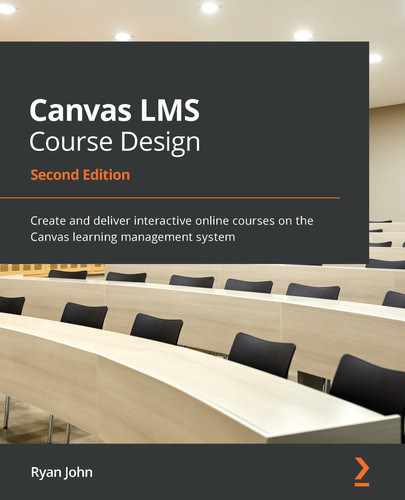Table of Contents
Preface
Section 1: Designing and Creating Your Course
Chapter 1: Getting Started with Canvas
Technical requirements
Reviewing instances of Canvas
Institution-specific instances of Canvas
Free for Teachers instance of Canvas
Accessing Canvas and creating your account
Accessing your institution's Canvas site
Creating a Free for Teachers account
Navigating Canvas
Adjusting your profile, settings, and notifications
Editing your profile
Adding a profile picture
Adjusting your account settings
Creating your Canvas course
Joining a course created by your institution
Creating a new course with a Free for Teachers account
Summary
Chapter 2: Building Your Canvas Course
Technical requirements
Planning your course – from syllabus to screen
Importing content from another course
Creating assignments
Adding an assignment
Editing an assignment
Using the Rich Content Editor
Publishing an assignment
Creating discussions
Adding a discussion
Pinning or closing discussions
Creating quizzes
Adding a quiz
Adding questions
Managing question banks
Creating assignment groups
Weighting assignment groups
Summary
Chapter 3: Getting Ready to Launch Your Course
Technical requirements
Choosing a Course Home Page layout
The Course Activity Stream layout
The Pages Front Page layout
The Course Modules layout
The Assignment List layout
The Syllabus layout
Selecting navigation links
Adding course calendar events
Testing your course with Student View
Adding participants to the course
Managing users
Creating user groups
Publishing your course
Summary
Section 2: Teaching and Enhancing Your Course
Chapter 4: Teaching Your Canvas Course
Technical requirements
Communicating through the Inbox feature
Learning the layout of the inbox
Composing and sending a message
Organizing your inbox
Posting announcements
Providing feedback and grades
Accessing the Gradebook and entering grades
Accessing and using SpeedGrader
Setting up synchronous meetings using Conferences
Creating a Conference
Starting and facilitating your conference
Summary
Chapter 5: Exploring Special Features
Technical requirements
Creating Collaborations
Editing or deleting collaborations
Setting up Outcomes
Creating outcomes
Creating Outcome Groups
Importing existing outcomes
Finding existing outcomes to use
Creating rubrics
Adding rubrics to assignments
Using rubrics for grading
Using the Learning Mastery Gradebook
Using Course Analytics and Course Statistics
Viewing Course Analytics
Viewing Course Statistics
Summary
Chapter 6: Utilizing and Integrating Apps
Technical requirements
Using Canvas on your mobile devices
Downloading and configuring the mobile app
Using the features of the mobile app
Navigating your course within the mobile app
Using the To Do feature of the mobile app
Viewing and sending messages within the mobile app
Accessing your settings within the mobile app
Finding help within the Canvas mobile app
Integrating external apps into your course
Summary
Section 3: Practical Ideas and Resources
Chapter 7: Where to Go for Help
Technical requirements
Finding help within Canvas
Exploring the Canvas Guides
Exploring other resources
Finding help outside of Canvas
Summary
Chapter 8: Now You're Ready!
Technical requirements
Exporting your course
Connecting Canvas to education in the 21st century
Enacting the Framework for 21st Century Learning
Looking to the future
Summary
Appendix: References and Resources
Teaching and learning in the 21st century
Battelle for Kids: Partnership for 21st Century Skills
Understanding by Design
Timeless Learning: How Imagination, Observation, and Zero-Based Thinking Change Schools
Creating Significant Learning Experiences: An Integrated Approach to Designing College Courses
Designing online learning environments
The Distance Learning Playbook, Grades K-12: Teaching for Engagement and Impact in Any Setting
The Interactive Class: Using Technology to Make Learning More Relevant and Engaging in the Elementary Classroom
How to Design and Teach A Hybrid Course: Achieving Student-Centered Learning Through Blended Classroom, Online and Experiential Activities
Discussion-Based Online Teaching to Enhance Student Learning: Theory, Practice and Assessment
The Gamification of Learning and Instruction: Game-Based Methods and Strategies for Training and Education
Conceptualizing online education
Closing the Gap: Digital Equity Strategies for the K-12 Classroom
Balance with Blended Learning: Partner with Your Students to Reimagine Learning and Reclaim Your Life
Essentials of Online Course Design: A Standards-Based Guide (Second Edition)
Best Practices for Teaching with Emerging Technologies (2nd Edition)
The Complete 15-Volume Jossey-Bass Online Teaching & Learning Library
Other online course design resources
Course Design Academy
The Blended Learning Toolkit
Distance Learning: A Gently Curated Collection of Resources for Teachers
Online Course Development Resources
The 5 Pillars – Sloan-C Quality Framework
Quality Matters: A National Benchmark for Online Course Design
Teaching Online: Design of an Online Course
CanvasLMS YouTube Channel
Why subscribe?
Other Books You May Enjoy
..................Content has been hidden....................
You can't read the all page of ebook, please click here login for view all page.
